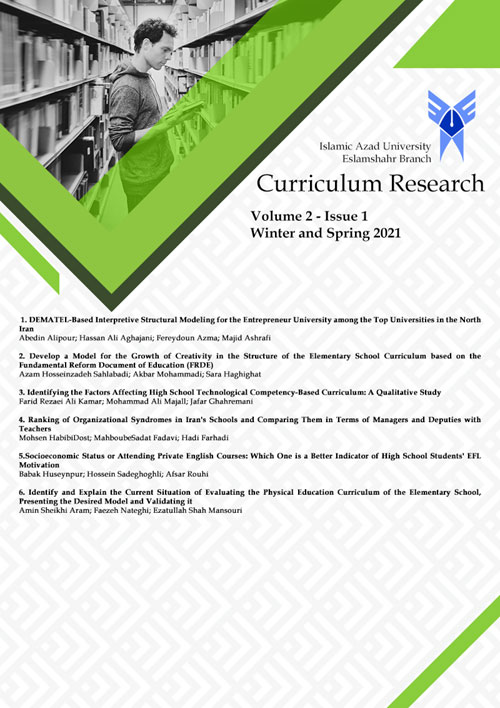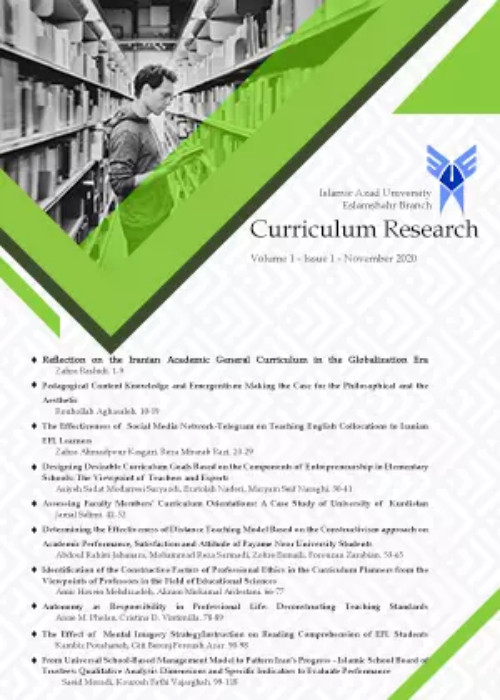فهرست مطالب

Curriculum Research
Volume:2 Issue: 1, Jan 2021
- تاریخ انتشار: 1400/09/23
- تعداد عناوین: 6
-
Pages 1-13Purpose
The present study aimed to present an interpretive structural model based on DEMATEL for the Entrepreneur University among top universities in the northern region of Iran.
MethodologyThis study was applied in terms of objective and combined (qualitative and quantitative) in terms of implementation method. The research population in the qualitative section were documents and texts of the Entrepreneurship University and experts in this field that 35 documents and texts and 30 experts were selected as samples according to the principle of theoretical saturation by purposive sampling method. The research population in the quantitative section consisted of the same 30 experts who rated the components. The research tools included text review, semi-structured interview, and 77-item researcher-made questionnaire that their psychometric indices were confirmed. Data were analyzed by Delphi methods and interpretive structural modeling based on DEMATEL in SPSS-23 and LISREL.
FindingsThe results showed that the Entrepreneurship University included 77 concepts, 24 sub-components in 6 main components. So that among the 6 main components, three components of infrastructure (with four sub-components), management (with five sub-components), and communication with the population (with four sub-components) were identified as effective variables, and three components of services (with three sub-components), knowledge-based entrepreneurship (with five sub-components) and output and outcome (with three sub-components) were identified as affected variables. The results of DEMATEL-based interpretive structural modeling showed that in the first level with 10 components, the component of commercialization of knowledge and research and revenue generation from advanced technology, in the second level with 7 components, the component of entrepreneurial research, R&D, and dissemination of academic results, in the third level with 14 components, the component of entrepreneurial research, R&D and dissemination of academic results, and in the fourth level with 1 component, the core component of strong leadership and change in structural and managerial dimensions were at a higher level.
ConclusionAccording to the results of the present study, planners and higher education professionals can take advantage of the results of this study and plan for the improvement and growth of the Entrepreneur University through the effective components identified in it.
Keywords: University, Entrepreneur University, Interpretive Structural Modeling -
Pages 14-22PurposeAs regards the effect of creativity and models for the growth of it, this study endeavors to develop a pattern model for the purpose of growing creativity in the structure of the elementary school curriculum based on the fundamental reform document of education (FRDE)MethodologyAs for the purpose of this study, it was conducive. Furthermore, in view of the procedure of methods, it could be considered as qualitative. 10 individuals of statistical society were chosen by targeted and snowball sampling methods in 2019. We utilized methods of reviewing the fundamental reform document of education and Semi-structured interviews. Validity and Validity of these methods were desperately examined by triangulation methods of data collection which were suitable for assessment and the coefficient of the agreement was estimated to be 0.76. Ultimately coding method was used in order to analyze the gained data of reviewed documents and interviews.FindingsResults demonstrated that 25 codes belonged to the growth model of creativity in the structure of the primary school curriculum based on the fundamental reform document of education while 15 codes are known to be relevant to this model based on interviews that have gotten done with some experts of the elementary school curriculum. Consequently, the model for the growth of creativity in the structure of the elementary school curriculum was designed based on these codes.ConclusionsResults of the present study contain some practical functions. Moreover, identified codes and designed models were used in order to improve the model of growth in creativity.Keywords: Creativity, Curriculum, Elementary Course, Document of Fundamental Transformation
-
Pages 23-34PurposeThe aim of the present study was to identify the factors affecting the high school technological competency-based curriculum.MethodologyThis was an applied study in terms of purpose and qualitative in terms of methodology. The research population included the documents and experts of the technological competency-based curriculum in Tehran during 2018. Of these, twelve were selected as a sample according to the principle of theoretical saturation and purposive sampling. The research instrument included a semi-structured interview whose validity was confirmed by the triangulation method and its reliability was estimated at 0.85 by calculating the interrater agreement coefficient. Data analysis was carried out using open, axial, and selective coding methods in MAXQDA software.FindingsThe results showed that the factors affecting the high school technological competency-based curriculum consisted of 66 concepts, 15 components, and 6 dimensions. The dimensions included network infrastructure status (with two components of access and quality), communication and interaction tools (two components of simultaneous and simultaneous tools), non-technical competencies and technical skills (with three components of knowledge, skills, and attitude), training facilitation strategies (three components of participation modeling, management, and supervision), training strategies to increase trust (with three components of trust, honesty, and appreciation) and management (with two components of time management and support).ConclusionAccording to the research results, the components, and dimensions identified for the factors affecting the high school technological competency-based curriculum, it is essential to have plans to improve it by promoting concepts, components, and dimensions.Keywords: Curriculum, technological competency, high school
-
Pages 35-57Purpose
Considering the importance of curriculum evaluation, the present study was conducted with the aim of identifying and explaining the current situation of evaluation patterns in the elementary period physical education curriculum: Presenting the desired model and its validation.
MethodsThe present study in terms of purpose was applied and in terms of implementation method was mixed (qualitative and quantitative). The research population, in addition to the documents and texts of evaluation the physical education curriculum, in both qualitative and quantitative sections were elementary period physical education curriculum experts in Lorestan province in the 2020 year, which according to the principle of theoretical saturation number of 10 people of them were selected as a sample by purposive sampling method. Data were collected by methods of taking noting, semi-structured interview and researcher-made questionnaires, which the validity of the interview was confirmed by the triangulation method and its reliability was obtained by the agreement coefficient method between the two coders 0.79 and the content validity of the questionnaire was confirmed by experts opinion and its reliability was obtained by Cronbach's alpha method 0.86. Data were analyzed by methods of coding, Friedman ranking, Kendall agreement coefficient, and exploratory factor analysis in SPSS and Smart PLS software.
FindingThe coding results showed that the evaluation pattern of the elementary period physical education curriculum has 85 indicators and 9 categories including purpose (21 indicators), content (11 indicators), learning resources (10 indicators), learning activities (7 indicators), implementation method (12 indicators),
Keywords: Evaluation, Curriculum, physical education, optimal model, the current situation -
Socioeconomic Status or Attending Private English Courses: Which One is a Better Indicator of High School Students' EFL MotivationPages 46-56The present study aimed to shed light on the relationship among students' socioeconomic status, self-reported English proficiency level, the length of attending private institutes, and L2 motivational factors namely: ideal L2 self, ought-to L2 self, L2 learning experience, integrative motivation, and intended effort. Participants were 320 Iranian students studying English at high schools in Tehran, the capital city of Iran. Data collection included EFL motivational factors adopted from Taguchi, Magid, and Papi (2009), socioeconomic status, and demographic information. The results of the Spearman Rho test revealed a weak or no meaningful relationship between the student's socioeconomic status and their L2 motivation suggesting that socioeconomic status is not an indicator of the school students’ EFL motivational factors regarding tripartite variables of Dörnyei's L2 Motivational Self System as well as integrative motivation and intended effort. However, the length of attending private language courses and the English proficiency of the students indicated moderate correlations with their L2 motivation and socioeconomic status. Current findings bear a clear message to the Iranian education policymakers that despite adopting a communicative approach in the latest official EFL coursebooks of schools, non-official private language institutes still perform more effectively than the Iranian formal education system in maintaining and enhancing the EFL motivation of learners.Keywords: ideal L2 Self, ought-to L2 Self, English language teaching, private language institutes, socioeconomic status
-
Pages 58-67Purpose
The aim of the article is Ranking of Organizational Syndromes in Iran's Schools and Comparing Them in Terms of Managers and Deputies with Teachers.
MethodsThis study in terms of purpose was applied and in terms of implementation method was descriptive form type of quantitative. The research population was the managers, deputies, and teachers of Isfahan and Yasuj cities in the 2019-20 academic years. The research sample according to Krejcie and Morgan's table was estimated at 375 people who were selected by multi-stage cluster sampling method with the volume ratio of cities. The research tool was a researcher-made questionnaire of organizational syndromes in Iran's schools with 78 items, which its content validity was confirmed by experts' opinion and its construct validity was confirmed by the exploratory factor analysis method and its reliability was calculated 0.93 by Cronbach's alpha method.
FindingThe results showed that the organizational syndromes of narcissistic, lack of communication, discrimination and politicking, group thinking, structural alienation, tension and distress, structural mastery, caution, pressure, terrorism, neglect, immobility, explosive, incompatibility, non-commitment, impulsive and silence had higher rankings in Iran's schools, respectively. Other results showed that there was no significant difference between organizational syndromes in Iran's schools in terms of managers and deputies with teachers (P<0.05).
ConclusionAccording to the results of the present study and the negative role of syndromes in the decline of school performance, designing and implementing programs is necessary to reduce syndromes via improving intra-organizational and extra-organizational relationships and activities in Iran's schools.
Keywords: Organizational Syndromes, Schools, Managers, Deputies, teachers


